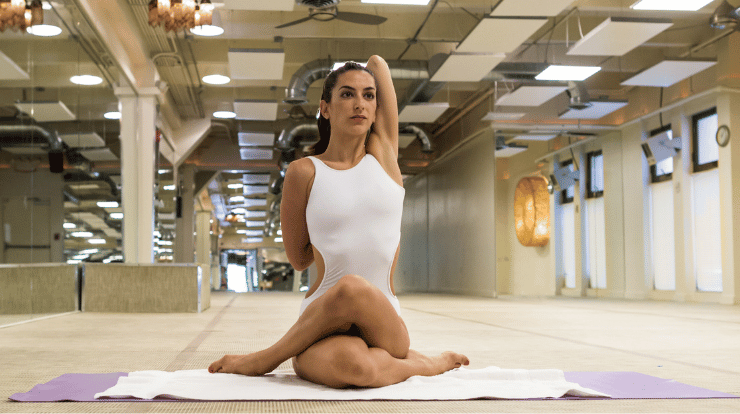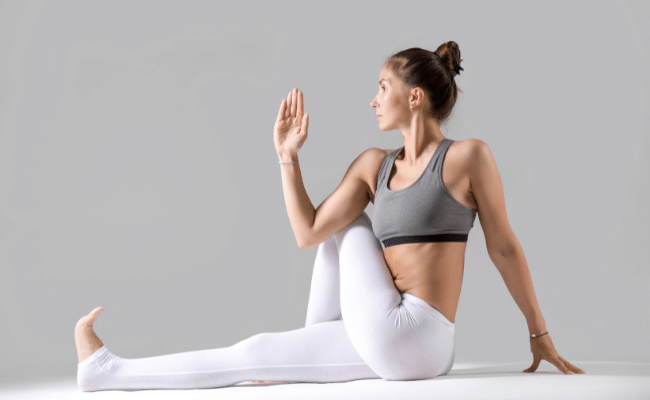
Prenatal yoga has many benefits. For pregnant women, prenatal yoga can help with back pain, prenatal depression and anxiety, sleep deprivation, and more. Yoga is also a great way to get some exercise while pregnant.
Is prenatal yoga good for you?
Prenatal yoga is touted as a great way to help prepare your body for labor, but how effective is it really? Regular prenatal yoga practice increases flexibility and strengthens the muscles that will be used in labor. It also helps you become more aware of your body’s position so that when you’re pushing, you’ll already be well-practiced at knowing what positions will work best. Finally (but most importantly), regular yoga practice relieves stress and anxiety—which contributes to less pain during labor and delivery.
Prenatal yoga could help:
- Lower blood pressure
- Lessen stress levels
- Improve sleep quality
- Strengthen muscles (including those supportive of the uterus)
- Aid in delivery by increasing flexibility of muscles around hips and pelvis
- Ease pelvic pain and reduce swelling
- Improve energy levels and maintain an overall healthy body
But there are some drawbacks to prenatal yoga, too:
In fact, if it’s not done in a safe manner or with good instruction from someone who knows their stuff, then it can actually do more harm than good. While yoga can be a great way to prepare for labor, you should first consult your doctor or midwife before starting any exercise program during pregnancy. Yoga done incorrectly can place undue stress on the joints and ligaments of the pelvis; if you’ve had a pelvic injury in the past this could exacerbate preexisting issues and increase your risk of an unstable pelvis.
You also want to make sure that you’re doing yoga with proper alignment—and that all movements are tailored to accommodate your stage of pregnancy. Not only will it give you a greater sense of security as far as making sure every pose is safe (as opposed to just “not dangerous”), it’ll help keep your weight off of delicate abdominal organs like the bladder which sits below the pubic bone.
Is prenatal yoga beneficial?
yes. most definitely. prenatal yoga is very beneficial to expectant mothers. there are many benefits for both mother and baby, including:
- Increased blood flow to the pelvic area
- Increasing flexibility of the hips, pelvis, and back
- Improved posture
- Comfort during pregnancy with reduced aches and pains
- Increased circulation throughout the pelvis and uterus
- Relaxation
- Reduced anxiety
- Increased muscle tone

1) Increased blood flow to the pelvic area: which promotes healthy organ development in the placenta and uterus, as well as muscle strength in the legs.
2) Increasing flexibility of the hips, pelvis, and back: this allows you to move through those areas more freely during labor while maintaining proper alignment of your body parts with each other. it also helps to reduce stress on joints that may be weakened due to pregnancy (such as knees, ankles & spine), once again allowing for easier movement during labor while avoiding injury/physical problems from prolonged times in certain positions (like squatting)
3) Improved posture: as a result of the above-mentioned flexibility (stronger muscles = better posture)
4) Comfort during pregnancy with reduced aches and pains: due to muscle mass supporting your growing body weight
5) Increased circulation throughout the pelvis and uterus: this allows for greater iron absorption and production of red blood cells, which in turn delivers more oxygen to your baby while keeping both you and your baby healthy. This is especially important later on in pregnancy when the baby’s lungs are developing (weeks 24-28) and little ones need that extra bit of oxygen — so prenatal yoga will help ensure adequate amounts get through to them!
6) Relaxation: it’s hard not to relax when you’re surrounded by soothing music, good company, and the beauty of the yoga studio around you! prenatal yoga is a wonderful way to destress your day by taking time for yourself; it’s great to be outside, away from the stress of life. whether you are practicing on your own or with a group, it can really help make pregnancy more enjoyable while taking advantage of all that prenatal yoga has to offer.
7) Reduced anxiety: with a busy mind comes an increase in feelings of stress. relieving that stress through proper breathing and stretching techniques promotes relaxation and helps ease anxiety — especially because most women feel overwhelmed at some point during their pregnancy (and often multiple times). separating one’s self from everyday chaos can do wonders for the psyche, rejuvenating one’s ability to cope with the strain of pregnancy and the demands that come with baby preparations.
8) Increased muscle tone: which can aid in labor by having more stamina to push (which is a muscle-dependent event) and having a stronger core to maintain proper posture during delivery (e.g., keeping your back straight); it also aids in postpartum healing through reduced soreness and injury from over-stretching that may occur during delivery and have negative effects on future activities.
Is Prenatal Yoga Safe in the First Trimester?
Prenatal yoga is safe in the first trimester and any time during your pregnancy. The only pregnant women who should avoid doing prenatal yoga are those who have preterm labor or high blood pressure. Learning a series of poses for relaxation, strength building, breathing, balance, and mobility prepares you for birth by strengthening muscles and articulations as well as increasing flexibility.
Most importantly it gives you a feeling of accomplishment and confidence that can carry you through to delivery. Pregnant women find emotional relief from prenatal yoga through active meditation which increases circulation to the heart while releasing endorphins which make them feel more relaxed. Yoga has been called “the gift of life” because it not only reduces stress but helps with all symptoms of pregnancy including morning sickness.
What poses to avoid?
Avoid practicing inverted poses like shoulder stand and headstand because they may cause dizziness or fainting spells due to decreased blood flow to the brain during pregnancy. These poses aren’t recommended until after the first trimester is over, but if you feel comfortable doing them, there’s nothing wrong in practicing them after consulting your doctor or midwife.
Prenatal Yoga Also Helps to Prevent Miscarriage!
Pregnancy Yoga will also help prevent miscarriage by keeping women physically and psychologically healthy. further increase blood circulation, increase body temperature which helps feels body more active and increases general wellbeing of pregnant women. it can be practiced until the end of the 12th week for most cases after which pregnancy yoga is discouraged and only prenatal yoga is advised.
Is Prenatal Yoga Safe in Second Trimester?
Yes! It’s perfectly safe to practice yoga in the second trimester. There are all kinds of benefits! In fact, you’re probably more likely than a non-exercising pregnant woman to deliver with shorter and less painful labor.
You’ll also decrease the chances of developing high blood pressure, gestational diabetes, or excess amniotic fluid around the baby. Plus, you can greatly reduce back pain and other common discomforts of pregnancy. The only disadvantage is that you may have to modify some poses when in your second trimester because your belly will be larger than it was during your first trimester.
In fact, Dr. Carol Phillips at Johns Hopkins has found that among women who exercised regularly prenatally (about 4-5 times per week), 85% went into spontaneous labor within 24 hours of their due date while 87% delivered within 48 hours! Among those who did not exercise during pregnancy: 46% went into labor spontaneously within 24 hours; 50% did so within 48 hours.
The best prenatal yoga practices overall (for both you and your baby) are gentle, rather than powerful or vigorous. Gentle flow styles of yoga that focus on body awareness, breathing, and stretching offer the most benefits to pregnant women because they ensure a gradual build-up of flexibility without over-stretching the abdominal muscles (which can cause an abdominoplasty).
Yoga poses that put pressure on the belly may be uncomfortable in later pregnancy but gentle stretches are just as effective for relieving lower back pain and improving flexibility. When in doubt it’s always better to do more gentle stretches than fewer powerful ones; this makes it safer to practice while pregnant!
Is Prenatal Yoga Enough Exercise?
To begin with, it’s remarkable how many women want to know whether they should exercise while pregnant. I’ve been asked this question countless times. It’s a shame that so few of us are confident about our bodies and the changes they’re experiencing; but truthfully, the desire to do something physically active is strong and good. Your body IS changing in ways you can’t control—you have every right to keep yourself as fit as possible. And if yoga helps you feel good AND sleep better too? Well, all the better!
If you just started doing prenatal yoga, or if you’ve been practicing for months now (or even years!), chances are you’re wondering what else you need to be doing during your pregnancy outside of class. It’s wise to remember that nothing we do can replace a doctor’s care—if you’re unsure about an exercise or practice, take it easy and see what your practitioner has to say. And some upcoming statements may surprise you: yoga is pretty much as good as it gets for prenatal fitness. When practiced properly, prenatal yoga is at the top of my list of recommendations for pregnant women.
(Think about that; there are actually very few things we would recommend to all pregnant women!) However, we also know that pregnancy is challenging enough on its own without succumbing to any more stress than necessary.

Is Prenatal Yoga Safe for High-Risk Pregnancy?
Yoga in pregnancy is safe for most women. However, before practicing any type of exercise routine, it is important to consult your healthcare provider. If you are a high-risk pregnant woman then prenatal yoga may not be recommended by your doctor. However, if your pregnancy is normal and without complications or concerns about safety then you can practice prenatal yoga freely and reap the benefits that this ancient art has to offer.
Although many recommend avoiding strenuous exercise during pregnancy.
How is prenatal yoga different from a regular yoga practice?
Prenatal yoga is performed within the safe limits of your pregnancy—in other words, you are taught how to modify all poses, as well as which poses to avoid completely. These modifications will help ease discomfort and pain around your growing abdomen. With more than thirty years of study in prenatal and neo-natal research, yogis have evolved what was once a purely spiritual practice into one that is health-conscious too.
Nowadays, there exist several types of classes tailored just for pregnant women that include proper alignment instructions (to avoid injury or unnecessary stress on the body), breathing exercises, relaxation techniques and meditation.






